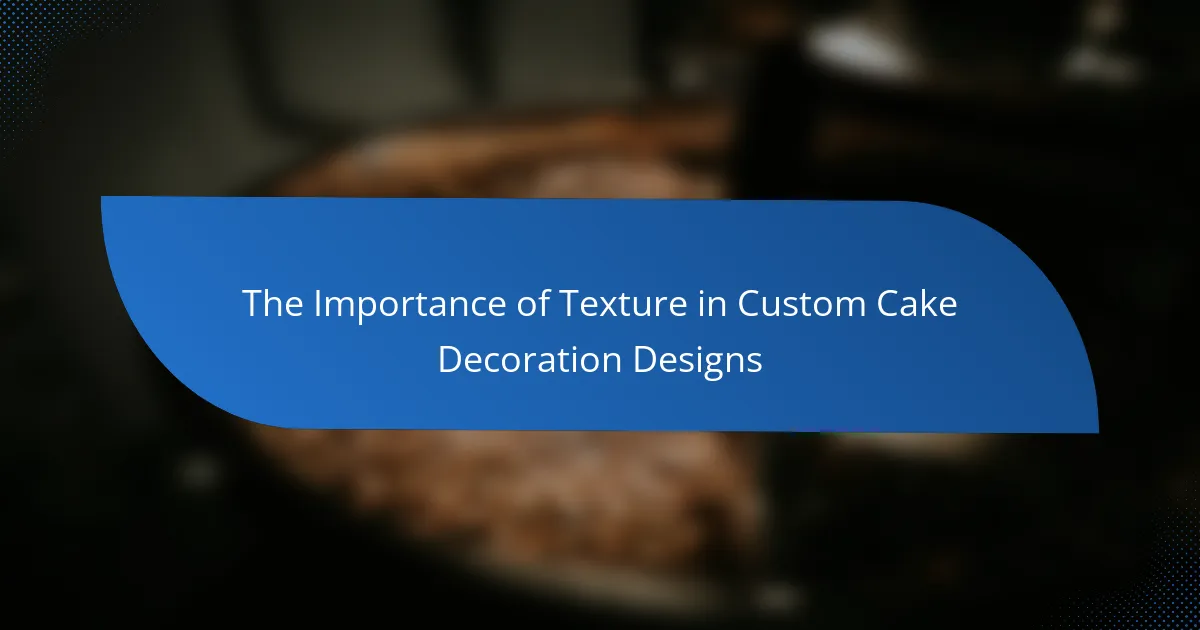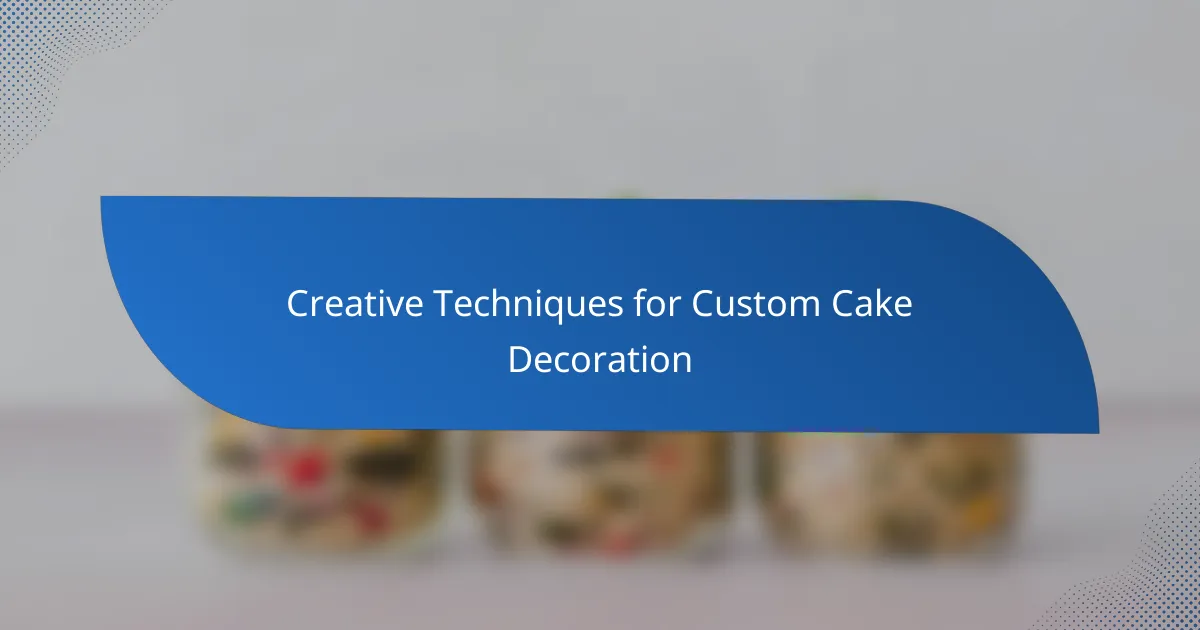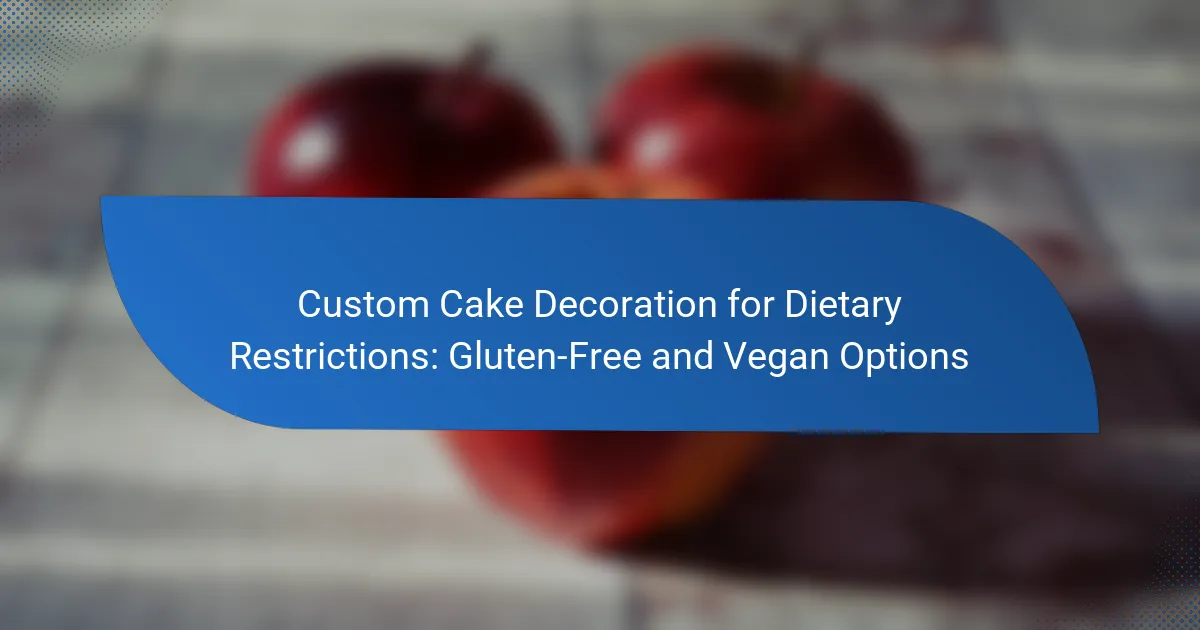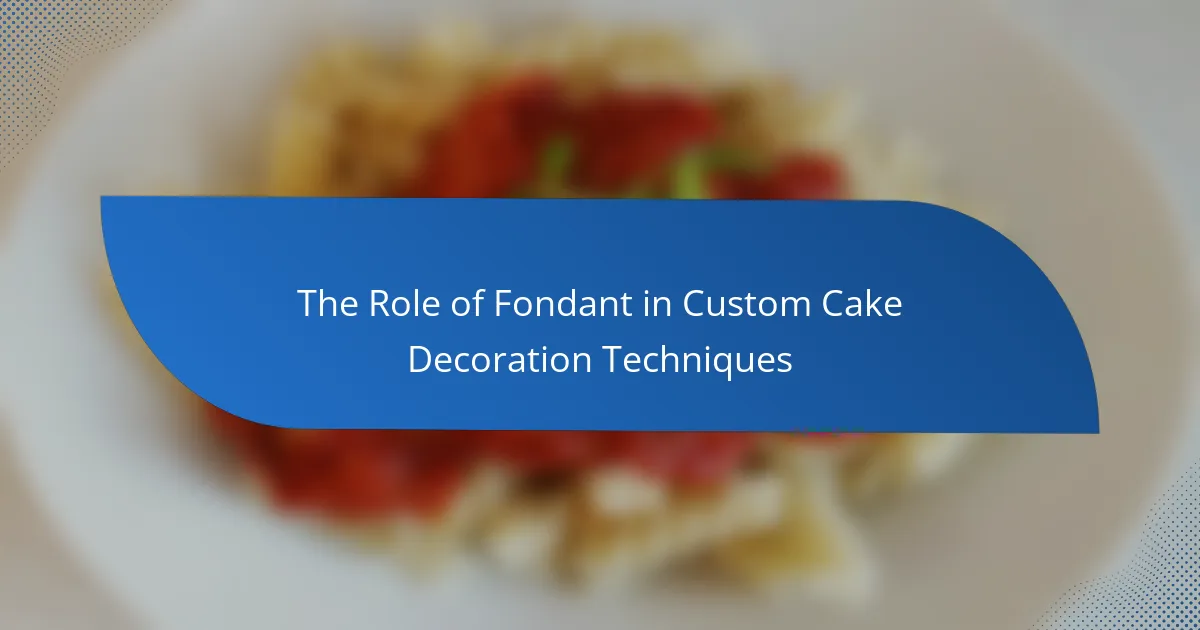Professional-looking custom cake decoration involves key elements such as design, technique, materials, and presentation. Design focuses on the cohesive aesthetic of the cake, while technique refers to the skills used, including fondant application, airbrushing, and piping. The choice of high-quality materials and vibrant colors enhances the cake’s visual appeal, and effective presentation on an appropriate stand elevates its overall look. Common mistakes in cake decoration, such as uneven layers or improper frosting consistency, can detract from the final appearance. Mastering these elements and avoiding pitfalls will result in a polished, professional cake.
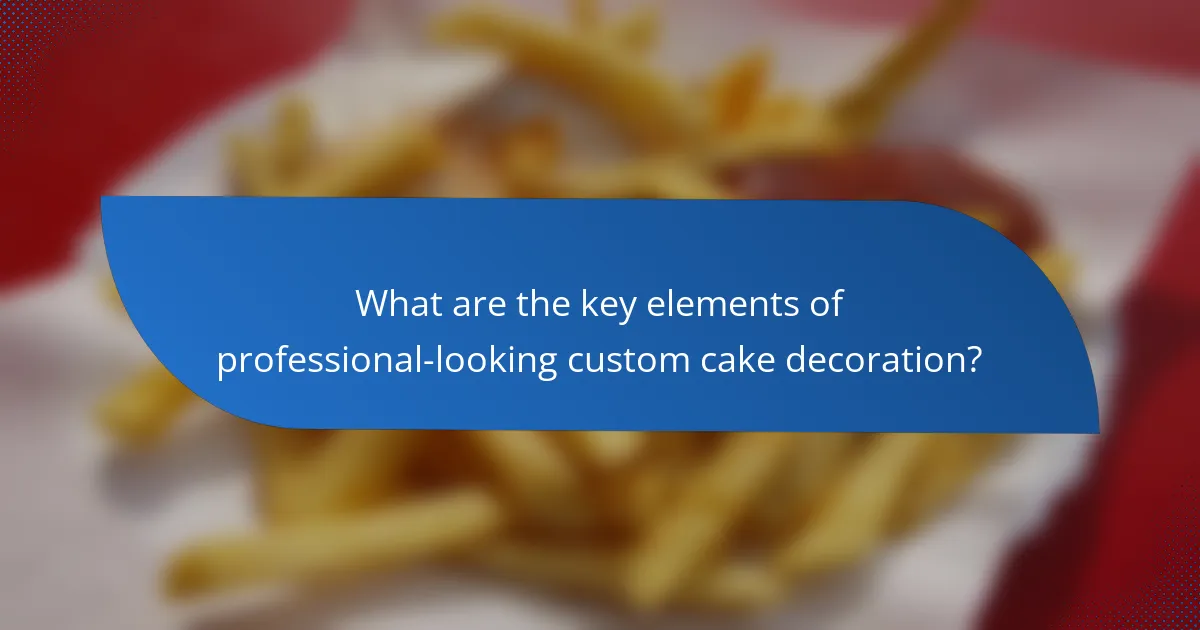
What are the key elements of professional-looking custom cake decoration?
The key elements of professional-looking custom cake decoration include design, technique, materials, and presentation. Design refers to the overall aesthetic and theme of the cake. It should be cohesive and visually appealing. Technique encompasses the skills used in decorating, such as piping, fondant application, and airbrushing. Mastery of these techniques contributes to a polished look.
Materials play a crucial role; high-quality ingredients and tools lead to better results. Using fresh, vibrant colors enhances visual appeal. Presentation is equally important; a well-presented cake on an appropriate stand or board elevates its overall look.
Consistency in decoration style across different elements also contributes to professionalism. Each of these elements, when executed well, results in a cake that looks professionally made.
How does the choice of cake type influence decoration techniques?
The choice of cake type significantly influences decoration techniques. Different cake types have varying textures and structures. For example, a dense cake like a pound cake can support heavier decorations. In contrast, a lighter cake, such as a sponge cake, requires more delicate decoration techniques.
Buttercream frosting works well on firmer cakes, providing stability. Fondant can be used on both firm and soft cakes, but it requires a smooth surface. Additionally, cakes with fillings may need special consideration for structural integrity.
Layered cakes often use stacking techniques, while sheet cakes may focus on surface decoration. The choice of cake type also determines the type of tools and materials needed for decoration. Thus, understanding the cake type is essential for achieving professional-looking results.
What are the most popular cake types for decoration?
The most popular cake types for decoration include buttercream cakes, fondant cakes, and sponge cakes. Buttercream cakes are favored for their smooth texture and versatility. They allow for intricate designs and vibrant colors. Fondant cakes provide a sleek, polished finish. This type is ideal for elaborate decorations and themed cakes. Sponge cakes are light and airy, making them suitable for stacking and layering. They can be easily flavored and filled, enhancing their appeal. These cake types are commonly used in professional cake decoration due to their adaptability and aesthetic potential.
How do different cake textures affect decoration methods?
Different cake textures significantly influence decoration methods. Dense cakes, like pound cakes, hold up well under heavy fondant and intricate designs. Their firmness allows for detailed sculpting and layering. Conversely, light and airy cakes, such as angel food cakes, require gentler decoration techniques. These cakes can easily collapse under heavy toppings. For moist cakes, like red velvet, buttercream is often preferred due to its ability to adhere without overwhelming the texture. Textured cakes, such as those with nuts or fruit, may need smoother icing to create a balanced appearance. Each texture necessitates a tailored approach to achieve a professional look.
What tools and materials are essential for cake decoration?
Essential tools and materials for cake decoration include piping bags, various nozzles, and spatulas. Piping bags allow for precise icing application. Different nozzles create varied designs and textures. Spatulas help in spreading frosting evenly. Fondant is crucial for creating smooth surfaces and intricate shapes. Food coloring enhances the visual appeal of cakes. Cake boards provide stability for decorated cakes. A turntable facilitates easy access while decorating. Lastly, decorative tools like brushes and molds add unique touches to designs.
Which basic tools should every cake decorator have?
Every cake decorator should have essential tools for effective decoration. These tools include a serrated knife for leveling cakes, a straight spatula for spreading frosting, and a turntable for easy access to all sides of the cake. Additionally, a set of piping bags and various tips are crucial for creating designs. A bench scraper helps achieve smooth frosting surfaces. Decorating combs can add texture to the frosting. Lastly, a cake board provides stability during decoration and transport. These tools are foundational for achieving professional-looking results in cake decoration.
What types of icing and fondant are best for achieving a professional look?
Buttercream icing and fondant are best for achieving a professional look. Buttercream icing provides a smooth finish and is easy to work with. It can be piped into various designs, making it versatile for decoration. Fondant offers a sleek, polished appearance and can cover cakes seamlessly. It allows for intricate designs and shapes, enhancing the overall aesthetic. Both options are favored by professional bakers for their adaptability and visual appeal.
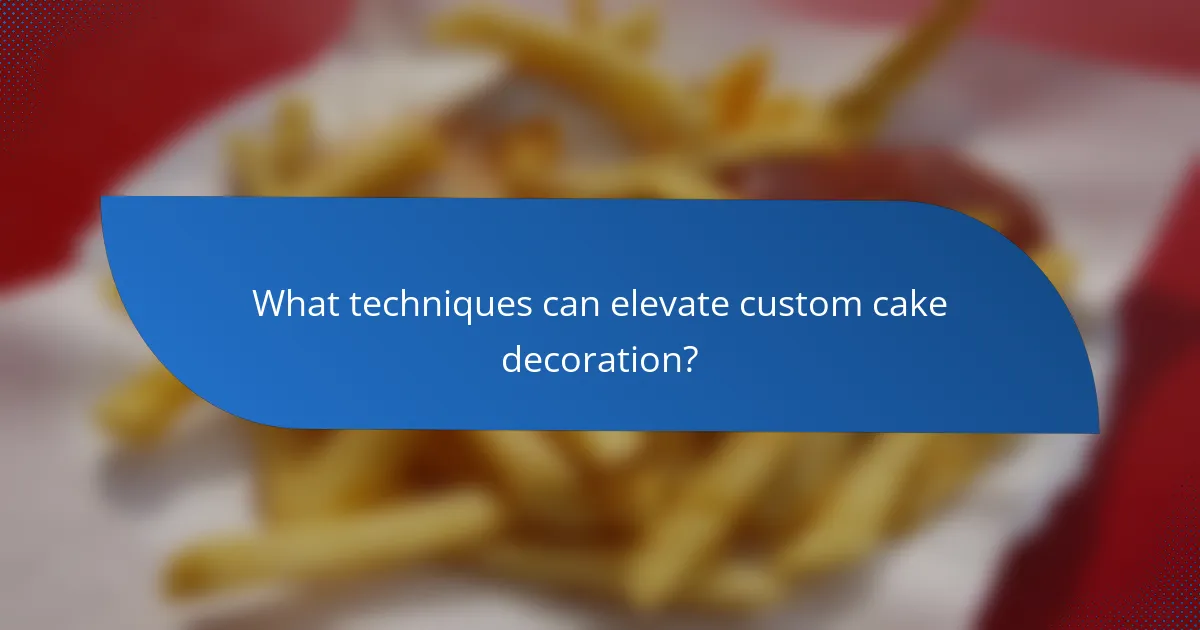
What techniques can elevate custom cake decoration?
Techniques that can elevate custom cake decoration include fondant application, airbrushing, and piping. Fondant creates a smooth, professional finish on cakes. It can be molded into various shapes and designs. Airbrushing allows for intricate color gradients and effects. This technique adds depth and dimension to cake surfaces. Piping techniques, such as royal icing, create detailed decorations. These can include flowers, borders, and lettering. Using edible glitter or metallic dust enhances visual appeal. Additionally, incorporating textures, like ruffles or lace, adds sophistication. Each of these techniques contributes to a more polished and artistic cake presentation.
How can color theory enhance cake decoration?
Color theory can enhance cake decoration by guiding the selection of harmonious color combinations. It helps decorators create visually appealing cakes that attract attention. Understanding color relationships, such as complementary and analogous colors, can improve the overall aesthetic. For example, complementary colors create contrast, making elements stand out. Analogous colors provide a more cohesive and soothing look. The use of color can also evoke emotions; warm colors are often associated with excitement, while cool colors can convey calmness. Studies show that colors can influence perception and appetite, making color choices crucial in cake design. Proper application of color theory can elevate a cake from ordinary to extraordinary.
What are the best color combinations for custom cakes?
Popular color combinations for custom cakes include pastels, bolds, and monochromes. Pastel combinations like pink and mint green create a soft, elegant look. Bold colors like navy blue and gold offer a striking contrast. Monochromatic schemes, such as varying shades of purple, provide depth and sophistication. Complementary colors, like orange and teal, add vibrancy and energy. Analogous colors, such as red, orange, and yellow, evoke warmth and cheerfulness. These combinations are often used in professional cake designs to enhance visual appeal.
How does color impact the overall presentation of a cake?
Color significantly impacts the overall presentation of a cake. It influences visual appeal and can evoke emotions. Different colors can signify various themes or occasions. For example, pastel colors often suggest a soft, elegant look. Bright colors can create a fun and festive atmosphere. Color combinations can enhance or detract from the cake’s design. Studies show that people perceive flavor based on color alone. Thus, the right color palette can enhance the perceived taste of the cake.
What are the most effective techniques for applying icing and fondant?
The most effective techniques for applying icing and fondant include proper surface preparation, using smooth application tools, and ensuring the right consistency. First, prepare the cake surface by leveling and crumb-coating it. This creates a smooth base for icing. Next, apply icing using a spatula or a piping bag for even coverage. For fondant, roll it to the desired thickness before draping it over the cake. Smooth the fondant with a fondant smoother to eliminate air bubbles and wrinkles. Additionally, using cornstarch or powdered sugar can prevent sticking during application. These techniques enhance the overall appearance and finish of custom cake decorations.
How can smooth icing surfaces be achieved?
Smooth icing surfaces can be achieved by using a few key techniques. First, ensure the cake is level and free from crumbs. A crumb coat, which is a thin layer of icing, should be applied to seal in crumbs. After chilling the cake, apply a thicker layer of icing. Use a spatula or a bench scraper to smooth the icing evenly. Heat the spatula or scraper slightly for better results. Finally, a gentle touch can help refine the surface. These methods are commonly used by professional bakers to create flawless finishes on cakes.
What are the best practices for working with fondant?
Use a clean, smooth surface when rolling out fondant. This prevents sticking and ensures even thickness. Dust the surface with cornstarch or powdered sugar to aid in rolling. Keep fondant covered when not in use to prevent drying. Knead fondant until it’s pliable before using it. Use a rolling pin to achieve a uniform thickness. Apply a thin layer of buttercream or ganache to the cake for better adhesion. Use fondant tools for shaping and smoothing edges. Store fondant in a cool, dry place to maintain its texture.
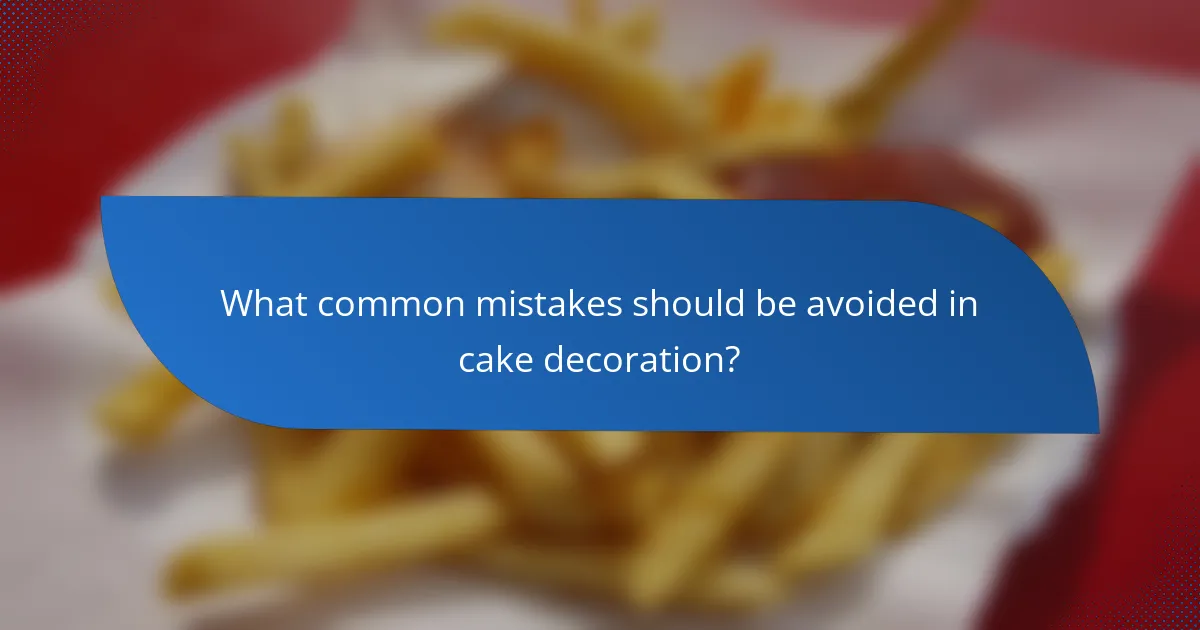
What common mistakes should be avoided in cake decoration?
Common mistakes in cake decoration include not leveling the cake layers. Uneven layers lead to a lopsided appearance. Another mistake is using the wrong consistency of frosting. Too thick or too thin frosting can affect the smoothness of the finish. Additionally, neglecting to chill the cake before decorating can cause the frosting to slide. Failing to use a turntable can make it difficult to achieve even results. Overloading the cake with excessive decorations can overwhelm the design. Lastly, not practicing piping techniques can result in messy designs. Each of these mistakes can significantly impact the final look of the cake.
What are the pitfalls of over-decorating a cake?
Over-decorating a cake can lead to several pitfalls. It may overwhelm the cake’s flavor and texture. Excessive decorations can distract from the cake’s primary taste. This can result in an unbalanced dessert experience. Overly intricate designs may also compromise structural integrity. Heavy decorations can cause the cake to collapse or become unstable. Additionally, over-decorating can increase preparation time and costs. It may lead to wasted materials if the result is unsatisfactory. A cluttered appearance can detract from a professional look. Simple designs often highlight the cake’s quality better than excessive embellishments.
How can simplicity enhance the overall design?
Simplicity enhances overall design by creating clarity and focus. A simple design allows key elements to stand out. It reduces visual clutter, making the design more appealing. According to research by the Nielsen Norman Group, users prefer clean, straightforward designs. This preference leads to better user engagement and satisfaction. In cake decoration, simplicity can highlight the cake’s features. It allows colors and textures to be more pronounced. Simple designs often convey elegance and sophistication.
What are the signs of a poorly decorated cake?
Signs of a poorly decorated cake include uneven frosting application. This results in an unprofessional appearance. Another sign is mismatched colors that clash rather than complement each other. Poorly executed piping can create messy designs or smudges. Additionally, visible cake layers or crumbs showing through the frosting indicate insufficient coverage. A lack of symmetry in decorations often detracts from overall aesthetics. Lastly, excessive or insufficient decorations can overwhelm or underwhelm the cake’s appearance. These signs collectively reflect a lack of attention to detail in cake decoration.
How can decorators troubleshoot common issues?
Decorators can troubleshoot common issues by identifying specific problems during the decoration process. Common issues include uneven icing, color bleeding, and structural instability. To address uneven icing, decorators can use a bench scraper for smooth application. If color bleeding occurs, using gel food coloring can help maintain vibrancy. Structural instability can be resolved by ensuring cakes are cooled properly before decorating. Additionally, decorators should check for proper support with dowels or cake boards. These strategies help maintain the integrity and appearance of the cake.
What solutions exist for common icing problems?
Common icing problems can be addressed with specific solutions. For icing that is too thick, adding a small amount of milk or water can improve consistency. If icing is too runny, incorporating powdered sugar can thicken it effectively. For icing that does not hold shape, using a stabilizer like meringue powder can enhance its structure. If the icing is grainy, beating it longer can help achieve a smoother texture. For color that fades, using gel food coloring can provide more vibrant results. If the icing cracks, ensuring a proper moisture balance in the cake can prevent this issue. These solutions are widely recognized among bakers and can help achieve a professional finish in cake decoration.
How can one fix cracks or tears in fondant?
To fix cracks or tears in fondant, apply a small amount of water to the damaged area. Use your fingers to gently smooth the fondant, blending it into the surrounding surface. If necessary, add a tiny piece of fresh fondant to fill in larger cracks. Ensure the new piece is well-moistened for better adhesion. After smoothing, let the fondant rest for a few minutes to set. This method is effective because water helps to rehydrate the fondant, allowing it to become pliable again. Proper handling prevents further damage and maintains a professional appearance.
What are some practical tips for achieving professional-looking custom cake decoration?
Use high-quality ingredients for your cake and frosting. Quality affects taste and appearance. Invest in good food coloring for vibrant hues. Use gel colors for better results than liquid dyes. Practice piping techniques with different tips for varied designs. Consistent pressure creates smooth lines and shapes. Level your cakes before stacking to ensure stability. A level cake looks more professional. Use a turntable for even frosting application. This tool allows for smooth, circular motions. Chill your cake before decorating to set the frosting. A cold cake is easier to work with. Finally, add decorative elements like fresh flowers or edible glitter for finishing touches. These details enhance the overall look.
The main entity of the article is professional-looking custom cake decoration. The article outlines essential elements such as design, technique, materials, and presentation that contribute to a polished cake appearance. It discusses how cake type influences decoration methods, the importance of tools and materials, and effective icing and fondant application techniques. Additionally, it covers common mistakes to avoid, troubleshooting tips, and practical advice for achieving high-quality results in cake decoration. The article emphasizes the significance of color theory and simplicity in enhancing the overall aesthetic of custom cakes.
